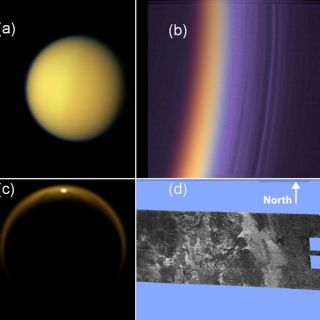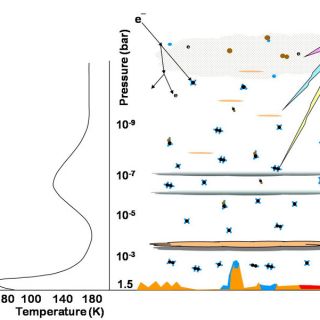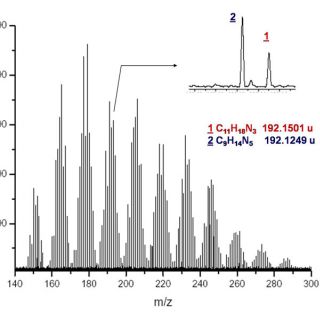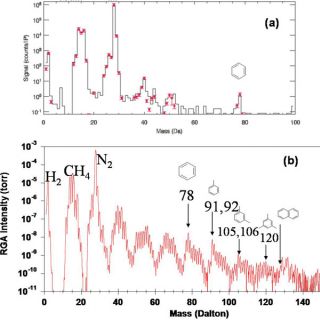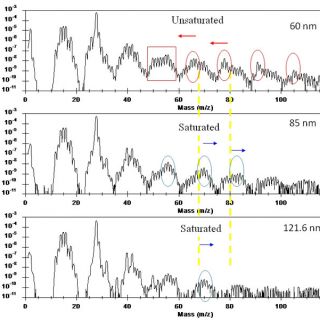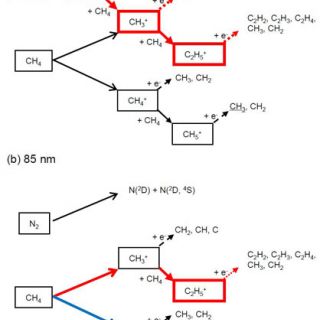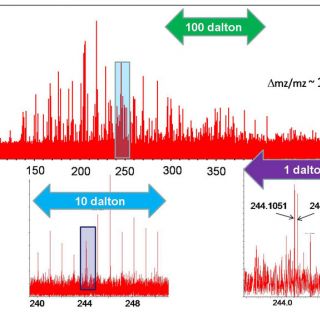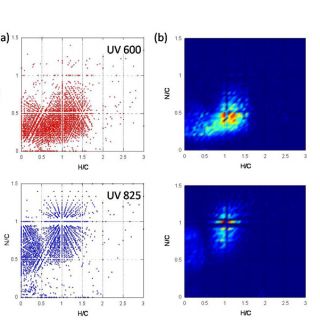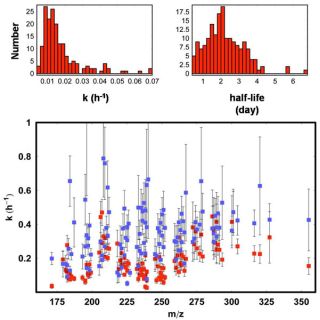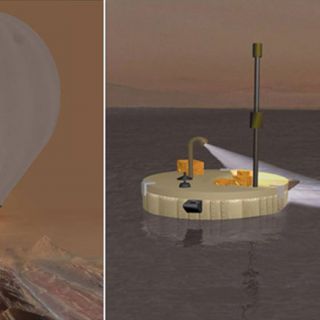Mark A. Smitha,b,* Hiroshi Imanakaa,b
a Department of Chemistry and Biochemistry, 1306 E. University Blvd., University of Arizona, Tucson, AZ 85721 USA.
b Department of Planetary Science, Lunar and Planetary Laboratory, University of Arizona, Tucson, AZ 85721
*Corresponding author. Email address: msmith@u.arizona.edu
Received February 2010; accepted in revised form 17 March 2010; available online 23 March 2010
Keywords: Titan, organic chemistry, prebiotic, abiotic
I. Introduction: Complex organic chemistry outside of the terrestrial envelope
The chemistry of the terrestrial environment is dominated by carbon. Carbon plays a critical role in the chemical balance of our oceans, in controlling the optical and therefore thermodynamic properties of our atmosphere and in determining the fundamentals of life. This centrality is partially governed by its unique set of balanced oxidation/reduction properties, its modest but significant tetrahedral valence and its prevalence in the matter that originally formed our solar system. Understanding the more fundamental origins as to why carbon plays an essentially unique and unmatched role in life science and why life, as we know it, has not developed with a greater elemental diversity is a continuing and difficult task. Though terrestrial life provides a broad spectrum of diverse systems of study, it is difficult to objectively study general prebiotic chemistry and gain an understanding of how carbonaceous or organic chemistry developed in an abiotic world or outside of the terrestrial box, so to speak. Biotic carbon is ubiquitous in our immediate world and it has been claimed that there is not a single carbon atom at our disposal on Earth which is not in a form previously influenced by a life process. Nascent carbon is beyond the reach of all of us, and accurate, verifiable simulations of the early organic chemistry of the solar system are fraught with difficulties, limitations and pitfalls.
The ability to observe, in nature, the development of abiotic chemistry, uninfluenced by contact with any life form, is critical to our understanding of the conditions extant during the precipitation of life on Earth or in our Universe. In order to understand the driving forces behind the complex intercouplings of chemical and structural diversity in what we believe to be the earliest life forms, we must understand the driving forces and couplings active in primordial matter. It is not clear how much of the symmetry and structural specificity we see in the chemistry around us has been generated and maintained by the forces, kinetics and thermodynamics of biochemical processes in living organisms and how much can be attributed to the natural chemical and physical forces present in highly complex chemical systems of arbitrary origin. To understand the transition between abiotic matter and a living system may not be as simple a question as we might wish.
If we are to seek the answers to the questions regarding the most fundamental definition of life and its origins it is wise to approach the problem not just from the direction of living examples but also ask, how far can the simple forces of physics and chemistry drive a complex abiotic chemical system? What levels of symmetry are maintained as such abiotic processes evolve to arbitrary complexity and do unbound abiotic systems possess non-equilibrium localities or simply evolve stochastically? The approach of retroanalysis from living matter to the simplest and most primitive biotic chemistry has yet to uniquely reveal the biotic/abiotic boundary. The latter approach beginning at the simplest chemical levels and building in complexity towards a prebiology has not received as much attention as it deserves, partly because it is maddeningly difficult to perform or analyze the correct studies, of sufficient complexity, in the common laboratory and looking for the answers beyond our earthly environment proves even more daunting. Looking outward is the natural approach towards understanding life beginning from the elements and in a way unbiased by the finite examples presented on Earth. In the outer reaches of our galaxy, the study of complex chemistry through observational astronomy has provided many surprises as to the paths complex molecular environments can follow (Herbst and VanDishoek, 2009). Using radio astronomy over the past 40 years alone, scientists have assembled a picture of complex chemistry, again dominated by carbon containing molecules, but including a plethora of molecules not observed in earthbound environments and only difficultly prepared in specific laboratories. At present there are over 150 molecules identified outside of our solar system, with our reach now extending deeper outside of our galaxy. The major chemical environments containing a complex organic chemistry are comprised of the out-flowing chemical clouds about stars, the dense interstellar molecular clouds where stars are born and to a lesser extent the highly rarified environment of the interstellar medium itself. It has become clear that the thermodynamic, radiation and kinetic conditions within these clouds create a unique set of chemical drivers. These conditions produce a chemistry which understandably appears to truncate at an exotic level, rich in functional groups and structures not common to denser media. From an organic or prebiotic chemical perspective, however, the chemistry appears to a simpler level than is expected from a prebiotic system. This picture is certainly highly filtered by the instrumental bias of the astronomical tools currently available. It is clear that if we are going to advance our understanding of molecular chemistry at the prebiotic level of complexity in the near term, it is necessary to look for more general sampling means somewhat closer to home.
Within our own solar system there are a broad range of intriguing and mysterious chemical systems of a complexity well deserving of close scrutiny. Ignoring those where we might seek remnants of a past active chemistry, the most notable thriving chemical environments are present on satellites within our solar system. The Jovian moon, Europa, possesses an ice crust below which appears to be an aqueous ocean thermally driven from the objects thermal core (Greenberg, 2005). Enceladus was recently discovered to be ejecting plumes of water from below its mantle, water which appears to be contributing to, if not responsible for, at least the E ring of Saturn (Hansen, 2006). Also within the Saturnian system lies the moon, Titan, which is the preeminent object of organic chemical interest within our solar system (Brown, 2009). With its rich, dense atmosphere of a few percent methane in nitrogen, its optically thick layers of organic aerosol haze and irrefutable evidence for liquid hydrocarbon lakes, mobile dunes of organic matter mixed with water ice and the presence of a molten sub-mantle aqueous reservoir, this object presents a diverse geochemical organic environment of richness unrivaled outside of Earth. If the pursuit of astrobiology centers about complex organic chemistry, then Titan must currently be accepted as the premier astrobiology laboratory.
Discovered by Huygens in 1655, Kuyper first detected the presence of carbon, in the form of its methane rich atmosphere in 1944. An object of long chemical interest, the Voyager mission, with Titan fly-bys in 1980 and 1981 revealed the first details of the complex organic nature of its atmosphere, rich in lesser constituents of ethane, ethylene, acetylene, hydrogen cyanide and cyanogen. Covered in an optically dense organic haze, see Figure 1, this shrouded world long defied any understanding beyond a plethora of competing models. However, it was not until the arrival of the Cassini-Huygens mission that the true geochemical mysteries of this object began to emerge (Brown, 2009). Since its arrival in 2005, the continuing Cassini (Saturn) orbiter mission has performed over 65 high altitude fly-bys. These fly-bys probe the Titan atmosphere at greater than approximately 1000 km, high in the ionosphere. In 2005, the Huygens probe was dropped to the Titan surface making the first direct measurements of the lower atmosphere of Titan and the very first direct images of its strange surface. The Huygens measurements have certainly been significant. However, from a chemical perspective, the Cassini data has been overwhelming in diversity, quality and volume. Most significantly, its optical, infrared and radar imagery have provided detailed insights into the physicochemical and geochemical structure of this shrouded world.
With a surface temperature near 95 K, most of the oxygen on Titan is believed to be frozen out as water ice. Yet the complex surface topography suggests that weathering, perhaps by periodic rain of condensed hydrocarbons has occurred in the past. This hypothesis is supported by direct observations of tropospheric cloud dynamics (Griffith, 1995; Roe, 2005; Schaller, 2009) and more recently definitive evidence of liquid hydrocarbon lakes in the northern latitudes (Stephan, 2010). In the equatorial plane are observed dunes believed to be comprised of organic solid particles deposited from the dense upper atmospheric haze layers. Current models suggest these haze layers are comprised of rich C, H and N containing aerosols produced by photochemical and energetic particle induced chemistry from an N2 and CH4 origin (Waite, 2009).
Though less is directly known regarding the haze layers, lying predominantly below the direct reach of Cassini, much is now known regarding the atmosphere above the haze. Using the Ion-Neutral Mass Spectrometer (INMS) on Cassini, we now know that even in the ionosphere, there is a rich and complex organic chemistry unparalleled in any known atmosphere (Waite, 2005; Waite, 2009). Using the Cassini Plasma Spectrometer (CAPS) originally designed to measure properties of the small ions and free electrons in the magnetosphere of Saturn, it has discovered that at the highest altitudes of the Titan atmosphere there exist surprising concentrations of very large charged particles, now believed to be the chemical seeds of the Titan haze (Coates 2007). Chemistry at these levels is driven by the solar extreme ultraviolet radiation (EUV) below 150 nanometers (nm) as well as the more minor energetic electrons entering the atmosphere guided by the strong saturnian magnetic field, as depicted graphically in Figure 2. The dissociation and ionization of nitrogen and methane leads to a reforming plasma which is now known to produce benzene, formimine and other complex molecules at regions of the atmosphere where on Earth only small atoms, ions and diatomics exist (Imanaka, 2007; Imanaka, 2009). The predominant difference being Titan's currently reducing methane rich atmosphere, a condition thought to be relevant however during the prebiotic stages of Early Earth. In fact, when one factors in the 100 times lower solar energy flux received by Titan relative to Earth, the resulting lower atmospheric and surface temperatures, and the positive activation energies of much of the complex neutral chemistry required to generate a prebiological chemistry, one can argue that Titan is geochemically reminiscent of Early Earth in its organic chemistry.
As a result, Titan has become a laboratory whereby planetary organic chemistry from its most fundamental stages is moving towards a palette of organic chemical diversity and complexity unknown in our solar system outside of Earth. We can observe directly the evolution and impact of the production of free atoms and light molecules as they evolve to moderately complex molecules. It is possible to probe this chemical environment for production of condensed molecules of surprising complexity. This developing, and presumably abiotic environment rivals the complexity which must have evolved on Early Earth before the generation of persistent molecular oxygen, the earliest stages of photosynthesis and ultimately life. We now possess a significant and growing set of direct data being used to drive models which can tie the observations together as well as lead to a predictive geochemistry. In addition, enough understanding exists from observation and reliable models to allow the design of significant laboratory studies, under known relevant conditions. These laboratory studies can lead to both model validation and observational interpretation as well as provide extension to systems (such as the Jovian) or conditions (as on Early Earth) for which we have much less understanding and for which direct data is currently not forthcoming.
II. Laboratory studies of Titan chemical processes
A. Atmospheric Chemistry
Meaningful laboratory investigations of planetary astrobiology really began with the groundbreaking study of Miller and Urey in the 1950's (Miller 1959). They prepared a gas mixture believed to be representative of the Early Earth atmosphere, containing nitrogen, methane, ammonia and water, and exposed it to an electrical discharge (representative of lightning and uv light) for days. Sampling of the crude resulting mixture revealed the presence of complex organic molecules including 11 of the 20 natural amino acids (in racemic form). Since then, several laboratories, beginning with that of the late Carl Sagan, have applied this approach to the investigation of complex molecule generation under Titan's somewhat simpler atmospheric mix, there being no appreciable ammonia or water in the upper atmosphere and no demonstrable lightning or intense energy sources in the lower. Even in this simpler gas mixture, nitrogen containing a few percent methane being well representative, an incredibly complex mixture of organics (dubbed tholins by Sagan) is formed from exposure to low energy (10's of volts) electrons within minutes. Figure 3 shows a representative solids mass spectrum from an electrical discharge product sample containing thousands of products. Mixtures such as these are believed to be possible analogs to the complex solids, such as the haze material, which form in the Titan atmosphere and settle to the surface. Before going further with solids discussion however, it is useful to take a closer and more controlled look at the beginnings of this chemistry in the highly rarefied environment of Titan's upper atmosphere.
In the earliest flybys of Cassini through the upper atmosphere of Titan, it was clear from the INMS mass spectra, that the atmospheric chemistry contained unimagined complexity. Figure 4a shows a low resolution spectrum from Cassini (using electron impact ionization, therefore producing signals from parent constituents as well as their ionization fragments) which shows a set of moderately complex organic molecules such as ethane, ethylene, acetylene, HCN, cyanogen, but also formimine and very surprising quantities of benzene (Waite, 2005; Imanaka, 2010). The benzene signal observed is 4 orders of magnitude greater than any model predicted at that time. In order to reconcile the discrepancy between model and observation, better understanding of the key contributing chemical processes is necessary and this is where laboratory studies can contribute. The issue here is not in refinement of the experimentally determined rate values inherent to the models, but here entire chemistries are obviously missing and it becomes critical that new pathways be unveiled through detailed experimental investigation.
Methane/nitrogen mixtures are photochemically inert to wavelengths above or to the red of 140 nm. Thus the primitive or nascent atmosphere absorbs predominantly only deep in the vacuum ultraviolet (VUV), where the first processes produce methane neutral fragments such as CH3 and CH2. To even begin exploring the photochemistry relevant to the Titan upper atmosphere, it is necessary to employ intense VUV and EUV (wavelengths below the window cutoff near 100 nm) exposure, most readily obtained from synchrotron light. Using the Molecular Dynamics endstation at the Advanced Light Source (ALS) at Lawrence Berkeley National Laboratory, we have at our disposal intense narrow band (Δλ ≈ 1 nm) radiation tunable between 150 and 50 nm. This covers the range of methane dissociation, methane ionization, nitrogen dissociation to both ground and excited state N atoms and nitrogen photoionization. Using a windowless photocell we have studied the wavelength dependent photo processes and Figure 4b shows a mass spectrum of a gas mixture produced upon methane/nitrogen exposure to 60 nm radiation, lying energetically above the nitrogen ionization potential. Here it is found that the nitrogen ionization product, N2+, is critical to the efficient production of benzene with a large variety of larger complex aromatics observed (Imanaka 2007; Imanaka 2009; Imanaka 2010).
Investigation of the full wavelength dependence of the photochemistry in this region suggests that though methane processes alone contribute to complex hydrocarbon generation, the products are more saturated, with higher hydrogen content, and that nitrogen in this atmosphere acts as an antenna absorbing the bulk of the radiation below its ionization onset at 79 nm (see Figure 5). The resulting N2+ then dissociatively ionizes methane to produce CH3+ which upon collision with methane produces the first CC bond containing constituent, C2H5+ as outlined in Figure 6. At the low pressures of the Titan atmosphere, such bimolecular processes yielding CC bond formation are unique to the ion chemistry and critical to the growth of the carbonaceous chemistry. Subsequent electron-ion recombination can then produce the complex neutral molecules which can begin to participate in these reactive growth processes.
In order to produce a prebiotic chemistry of relevance, it must include fixed nitrogen in the form of nitrogenous organics. HCN has been known to be a significant constituent of the Titan atmosphere, but only since Cassini have more complex nitrogenous molecules been identified. One of the most astrobiologically relevant of these is formimine (CH2NH). Such simple one carbon nitrogen bearing form from reactions involving methane or methane fragments and the excited forms of atomic nitrogen. Understanding the preparation of the higher possible CHN containing organics, presumed to contribute to Titan's orange tint, is more difficult. We can use synchrotron radiation once again to search for the key photo processes producing the higher nitrogenated species. Once again, production of the one carbon species are indicated at wavelengths where nitrogen is known to dissociate (λ < 95 nm) to atomic nitrogen in both the ground 4S and excited 2D states. However a search for higher order nitrogenated species in the gas mixture has been elusive. Using 15N and 13C isotopomers (organic molecules differing only in their isotopic distribution) of methane and nitrogen proves a very sensitive means to determine the C/N content in such muddled low resolution mass spectra as necessarily currently employed in our synchrotron investigations. These demonstrate to reasonable certainty that less that 5% of the product species above 40 daltons (and so, excluding single carbon atom species) in this wavelength region contain nitrogen (Imanaka, 2010). This surprising result contradicts the known N atom photo yields and the chemical expectations.
Under our experimental conditions, and those of the Titan ionosphere, the small molecule gas mixture is highly transparent to atomic nitrogen. On Titan, the second surprise of Cassini was the presence of reasonably large negatively charged 'nanoparticles' most likely the organic seeds of the subsequent haze. These particles, ranging to molecular weights near 10,000 dalton, present an appreciable collision target to the atomic nitrogen being produced in their vicinity. Similarly, in the laboratory studies, the hydrocarbon photoproducts rapidly produce a layer of (charged) hydrocarbons on the inside walls of the photocell which play a similar role to the CAPS particles on Titan. Energetic N atoms largely pass through the gas mixture and reactively collide with this organic surface, simulating the interaction of organic aerosol with energetic gas species. The high efficiency of these processes is confirmed by direct observation, through laser scattering, of the growth of the organic product films as well as their direct compositional analysis using laser desorption/ionization (LDI) mass spectrometry, as shown in Figure 7 and 8. The material detected contains a large diversity of very complex organics, essentially every one of which contains at least one nitrogen atom.
B. Aerosol processes
The evidence suggests that a wide variety of energetic precursors are contributing to the growth of the aerosol solids. The thin film solids, or trapped aerosols, possess significant reactive centers on their surfaces such as extended unsaturation, radical centers and charges. The heterogeneous growth process at low temperature does not allow for equilibrium chemistry and so significant chemical potential from the highly exothermic growth reactions locks up significant surface reactivity in the form of strained structure, unsaturation and dangling bonds. As the material grows, presumably this chemical potential is continuously buried resulting in a highly energetic material which never has the freedom to reach any form of local equilibrium.
The resulting aerosol then possesses a reactive potential unmatched by simple mixtures of complex organics. The Titan aerosols, likely formed in a similar reactive intermediate or heterogeneous growth mechanism, must also contain this high potential for subsequent chemistry. Their color is certainly consistent with high nitrogen content and high unsaturation. In the photo field of the upper atmosphere, their charge state must be high and their continual bombardment by open shell radicals and atoms, must lead to considerable open valence. Surface film growth naturally buries and protects much of this structure and potential reactivity in a highly nonequilibrium state that is retained in the solid material. This material slowly settles to the Titan surface (over years) and presents a rich and energetic feedstock for further chemical development. This material is a form of prebiotic fertilizer in many ways. The only problems with its further development are related to the conditions leaving it locked as a solid: the extremely low surface temperatures (near 95°K) and the apparent lack of significant liquid phase which could dissolve and release these active components.
This chemical potential can most easily be explored by investigating the kinetics of chemical reactivity of the dissolved aerosols. Titan is believed to have periodic episodes of liquid water on its cold surface either induced by energetic meteoritic impacts or via cryovulcanism (Jaumann, 2009). The impacts strike the icy surface liberating tremendous energy which models show can produce aqueous melt pools lasting hundreds or even thousands of years. The apparent lack of craters on Titan suggest the viability of this process as the models suggests the result is a set of topographically flat or neutral features composed of frozen water filled craters. Cryovulcanism, another potential source of liquid water on the Titan surface, is believed to originate from the sub-mantle liquid water layer believed to exist as a dense ammonia-water eutectic. This eutectic, when forced to the surface though faults, can present a minus 50 °C cryoflow, eventually freezing as the source flow ceases. Topographic evidence consistent with such flow characteristics have been identified in high resolution, synthetic aperture (SAR) radar images from Cassini. One observes large flat flow fields emanating from apparent caldera domes. In either of these mechanisms, aqueous mixtures are presented to settled aerosol organic 'soil'. The laboratory studies of plasma produced tholins suggest that this material should in general be highly soluble in such mixtures. The solubility releases all but the highest molecular weight insoluble components producing a solution which can undergo new chemistry.
Using the plasma generated tholins we have investigated the reactivity of dissolved tholins in both pure water and in ammonia/water mixtures at low temperatures (Neish, 2008; Neish, 2009; Neish, 2010). Contrary to the much longer timescales of these periodic melts on Titan, tholins in the laboratory are observed to undergo hydrolytic reactions with water mixtures at 0°C and below in minute to hour timescales as seen in Figure 9. The majority of the products possess only a single oxygen atom consistent with simple reactions. However, at longer times, multiple oxygen atom addition occurs. Recently, we have observed production of both amino acids and nucleobases in these hydrolysis mixtures (Neish, 2010; Horst, 2010). Amino acids had been observed in tholin hydrolysis reactions previously, but only under the extremely harsh and unrealistic conditions consistent with stubborn nitrile hydrolysis (pH of 1 at 100°C) (McDonald 1994). Observation of low temperature production of these more complex oxygen functionalities under natural pH is highly surprising, defying textbook models of carboxylic acid generation for instance. Though the structural features driving this unusual chemistry have as yet not been identified, they are clearly supportive of the concept that this material remains highly energetic in its solid phase and that this potential energy can be released to drive astrobiologically important processes under low temperature abiotic conditions.
III. Correlation between laboratory studies and mission data
Titan is arguably the most complex abiotic organic chemical environment in our solar system. In spite of the stunning success of the Cassini-Huygens mission, its data has only provided the smallest glimpse at the chemical environment on Titan. This is no fault of the mission and the certain continuing Cassini data analysis which will occur over the coming decade will do little unfortunately to advance this. The chemical instrumentation on Cassini, and the Huygens probe, was designed only for small molecule analysis. None of the instruments were designed in a way to provide structural information for anything but gaseous species. Of the instruments which provided reliable data, the best we can hope for is correlation between gaseous molecule identification, modeling of formation processes and laboratory validation. These limitations must be eliminated in future missions if we are to advance our understanding of abiotic chemical development to a stage of astrobiological or prebiotic relevance.
This is a daunting task. Flight instruments do not exist currently, which are capable of separating and identifying condensed phase species. Mass spectrometers with 'exact mass' resolving powers allowing absolute molecular formula assignment are not flight capable under current mission constraints. Structural analytic tools which can uniquely identify complex molecules of prebiotic complexity in gross mixtures, as they certainly will be in natural environments, have not been developed. Nor have the chromatographic methods of broad generality been demonstrated which can address the separation demands of these natural mixtures. However, if we are going to succeed in developing an understanding of prebiotic chemistry as it currently exists in abiotic pockets of our world (i.e., most of the universe?) then we must develop these tools as well as missions to take them to these worlds.
These instruments cannot be developed in isolation. An understanding of the nature of the mixtures and the separation problem must be reasonably defined in order to produce an approach with sufficient generality to be successful. The biases contained in the separation, as all techniques possess, must not exclude whole categories of structure or functional group. To approach this, a reasonable model of the environment must exist as well as a sufficient set of laboratory studies of the chemistry under the constraints surrounding those models or past mission observations. As we move towards a field study of prebiotic chemistry, it must be with a completely open mind, an appreciation for how complex organic chemistry in the field can evolve and a full understanding of the extreme difficulty of developing truly general and sensitive analytical tools.
Mass spectrometry has proven itself as a critical part of this analytical approach. Its biases are reasonable and well understood. Recent developments in ionization techniques allow its general application to any phase; gas, liquid, or solid. Coupled with even crude separation technology, its power in resolving gross mixtures is proving itself in current studies of the human body involving proteomics and the inventory of the processes occurring within single cells or even on single cell membranes. But it has become very clear that the next generation of flight capable mass spectrometers, if they are to be used for complex organics, must be 'exact mass' capable. This means that they have resolution values in excess of 106, such that exact molecular formulas can be assigned without ambiguity, so that isotope ratios in molecular mixtures can be made molecule specific and that the mass spectrometric identification of molecules can move into the 200 dalton and above prebiotic mass range.
Sampling technology, such as that depicted in Figure 10 for a follow-on mission to the lakes of Titan, must be developed such that molecular mixtures can be removed from their natural environments into that of the analytical instrumentation and presented for separation/identification without chemical alteration. Development ought to be cognizant of the fact that simple covalent structure may not be the only interesting analytical target. It may be that compositional micro-homogeneity, third order structure and paired correlations between components may be target information. Looking for organized chemical systems must go beyond general bulk chemical analysis and must be sensitive to molecular distributions. In life, and likely in pre-life, molecules will be correlated, either as membrane structures, polymeric assemblies or simply as byproduct pools amid a generally homogenous background.
Until now, we have not mentioned the molecular attribute of chirality which exists as soon as you get to reasonably sized organic structures of anything but the most mundane of functionalities. Chirality is a result largely of the tetravalent nature of carbon and is manifested in the observations that chiral molecules possess a handedness. This handedness, or the inability of isomeric forms to be superimposable on their mirror images, has critical importance in life as we know it. Terrestrial life has chosen homochiral pathways in its chemical processes that have no use for molecules of the wrong handedness. Thus only sugars of the right handed form are processed enzymatically and used for energy and only left handed amino acids are produced and used in proteins. The non-utilitarian isomers or enantiomers (the other hands) are largely suppressed in our environment since they are neither made nor used by living organisms. Man-made versions can again be largely ignored by the body as is the case of newer artificial sweeteners which are non-bioactive enantiomers that are sensed as being sweet but are metabolically ignored and therefore non. On the other hand (no pun intended), some can be quite toxic as was found in the 1950's when the unknown chiral isomer of the sedative, thalidomide, was found too late after drug trials on enantiomerically very pure material, to produce severe birth defects when less pure commercial material became available.
Chirality must, and eventually will play a critical role in the advancement of astrobiology (Lunine, 1999). There is no currently accepted explanation as to how terrestrial life developed along homochiral pathways. However, it is felt that a broad search for enantiomeric imbalance in natural organic compounds might be an excellent and simple means to screen for biological origins.
The next decades of space science will increasingly focus upon organic geochemistry. Motivators begin simply with the fact that organic chemistry presents a dimension of geochemistry not well explored in the past and which is ripe for discovery. Our increasing ability to design models and instruments capable of extending our understandings to ever more complex chemistries validate our interests. Naturally coupled to this capability is then a strong motivation to seek extraterrestrial evidence for biologically similar chemistry, prebiotic chemistry on the edge of life or the identification of chemical evidence of life beyond Earth. It is a fascinating time for chemically oriented space mission science and we must seize our opportunities, push our creative imaginations and extend our world beyond its current confines.
IV. Acknowledgements
This work is supported by NASA Exobiology Grant NNG05GO58G and the NASA Astrobiology Institute award NNH08ZDA002C. The Advanced Light Source is supported by the Director, Office of Science, Office of Basic Energy Sciences, of the U.S. Department of Energy under Contract No. DE-AC02-05CH11231.
V. References
Brown, R.H., Lebreton, J.-P., Waite, J.H., ed.s, (2009), Titan from Cassini-Huygens, Springer, Dordrecht, 535 pp.
Coates A.J., Crary F.J., Lewis G.R., Young D.T., Waite Jr., J.H., Sittler Jr., E.C., (2007), Discovery of negative ions in Titan's ionosphere, Geophys. Res Lett, 34: L22103.
Greenberg, R., (2005) Europa--the ocean moon: search for an alien biosphere, Springer, Dordrecht 384 pp.
Griffith, CA, et al, (2005) The evolution of Titan's mid-latitude clouds. Science 310: 474-477.
Hansen, C.J., Esposito L., Stewart A.I.F., Colwell J., Hendrix A., Pryor W., Shemansky D., West R., (2006) Enceladus' Water Vapor Plume. Science 311:1422-25.
Herbst, E.; van Dishoeck, E. F., (2009) Complex organic interstellar molecules. Annual Review of Astronomy and Astrophysics 47:427-480.
Horst S., Yelle R.V., Carrasco N., Sciamma-O'Brien E., Smith M.A., Somogyi A., Szopa C., Thissen R., Vuitton V., (2010) Formation of prebiotic molecules in Titan simulation experiments. Science, submitted.
Imanaka H., Smith M.A., (2007) The role of photoionization in the formation of complex organic molecules in Titan's upper atmosphere. J. Geophys. Res. Lett. 34:L02204-10.
Imanaka H., Smith M.A., (2009) EUV Photochemical Production of Unsaturated Hydrocarbons: Implications to EUV Photochemistry in Titan and Jovian Planets. J. Phys. Chem. A, 113:11187-94.
Imanaka H., Kellersberger, K.A., Smith M.A. (2010) Formation of nitrogenated organic aerosols by EUV-VUV irradiation of a simulated Titan atmosphere. Proc. Natl. Acad. Sci., submitted.
Lunine J.I., Beauchamp J., Smith M.A., Nikolaev A. (1999) The abiotic generation of homochirality on Saturn's moon Titan. Advances in Biochirality, Palyi G, Zucchi C, Caglioti L, eds., Elsevier, Oxford, 257-67.
Neish CD, Lunine JI, Somogyi A, Imanaka H, and Smith MA, (2008) Rate measurements of the hydrolysis of complex organic macromolecules in cold aqueous solutions: Implications for prebiotic chemistry on the Early Earth and Titan. Astrobiology 8:273-8. (2008).
Neish C.D., Somogyi A., Lunine J.I., Smith M.A., (2009) Low temperature hydrolysis of laboratory tholins in ammonia-water solutions: Implications for prebiotic chemistry on Titan. Icarus, 201:412-21.
Neish C.D., Somogyi A., Smith M.A., (2010) Titan's primordial soup: Formation of amino acids via low temperature hydrolysis of tholins. Astrobiology, in press.
McDonald G.D., Thompson W.R., Heinrich M., Khare B.N., Sagan C., (1994) Chemical investigation of the Titan and Triton tholins, Icarus 108:137-45.
Miller, S.L., Urey H.C., (1959) Organic compound synthesis on the primitive Earth. Science 130: 245-51.
Roe H.G., Bouchez A.H., Trujillo A.C., (2005) Discovery of temperate latitude clouds on Titan. Astrophys. J., 618: L49-L52.
Schaller E.L., Roe H.G., Schneider T., Brown M.E., (2009) Storms in the tropics of Titan, Nature, 460: 873-875.
Stephan K., et al., (2010) Detection of a specular reflection on Titan by Cassini-VIMS. 41st Lunar and Planetary Science Conference Proceedings, http://www.lpi.usra.edu/meetings/lpsc2010/pdf/1692.pdf.
Waite, J.H. et al., (2005) Ion neutral mass spectrometer results from the first flyby of Titan. Science 316:870.
Waite J.H., Young D.T., Westlake J.H., Lunine J.I., McKay C.P., Lewis W.S., (2009) High altitude production of Titan's aerosols, Titan from Cassini-Huygens, Brown RH et al., eds., Springer, Dordrecht, 201-214.
Figure Captions
Figure 1. Composite of Titan images from Cassini. (a) Titan atmosphere as seen in the visible spectrum. (b) Upper atmosphere limb view of the upper atmosphere haze layers (c) Titan at occultation showing the specular reflection of sunlight from a northern surface lake. (d) Radar image of complex surface tomography. (From JPL.NASA.gov)
Figure 2. A schematic illustration of the physical conditions on Titan that affect the diverse chemical processes. Hard ionizing radiation and electrons initiate chemistry in the ionosphere from nitrogen and methane. This rapidly develops a set of complex molecules which ultimately leads to condensate and/or organic chemical hazes. These hazes produce the surface feedstock for surface processes involving frozen water ice, periodic aqueous cryoflows or meteoritic impact melt pools and precipitated hydrocarbon lakes from the dense methane/ethane lower atmosphere.
Figure 3. A representative mass spectrum (electrospray ionization from a methanol/formic acid solution) of the complex mixture of organic solids (tholins) produced upon 50V dc discharge within 5% methane in nitrogen at 10 mbar. The spectrum was taken using a 9.4 tesla Fourier transform ion cyclotron resonance mass spectrometer with a mass resolution M/ΔM > 106. Each signal represents a single molecular formula, CxHyNz and each formula can be comprised of a single parent molecule or a mixture of isomeric parents. This spectrum represents in excess of 5000 different parent molecules present in the discharge mixture.
Figure 4. (a) Cassini mass spectrum of the Titan ionosphere near 1200 km that shows the presence of moderate size organic molecules. The points (red squares) are a fit to a subset of molecules including benzene (from Waite, 2005). (b) A laboratory mass spectrum of a low pressure 5% methane and nitrogen gas mixture exposed to 60 nm radiation, demonstrating the presence of nitrogen photoionization stimulated production of complex organics including the aromatics.
Figure 5. Averaged mass spectra of neutral gaseous species (EI = 70 eV) obtained by 60 nm, 82.5 nm and 121.6 nm (Lyman α) EUV-VUV irradiation of a N2/CH4 (=95/5) gas mixture. Highlighted on the mass spectra is the difference in the degree of saturation evident in the heavier organics, with 60 nm photolysis leading to a greater degree of unsaturated species. The proposed causative mechanism involves catalysis through the photoionization of nitrogen gas below 79 nm, which eventually produces protonated ethylene ( C2H5+) in methane rich mixtures.
Figure 6. Summary of initial chemical reaction pathways in complex molecule synthesis EUV irradiation of various methane mixtures. The estimated relative ratios of major ion species and other minor ions (hatched area) are also shown.
Figure 7. LDI mass spectrum of a 200 nm thick product thin film produced from 82.5 nm photolysis of a 5% methane in nitrogen gas mixture at 8 x 10-2 mbar. The spectrum was obtained from a roughly 10 micron diameter spot, using a single 330 nm laser shot without signal averaging.
Figure 8. Mass spectral information from LDI mass spectra of methane/nitrogen atmosphere EUV photolysis generated aerosol thin films (upper panel 60 nm photolysis; lower panel, 82.5 nm photolysis). (a) Van Krevalen plots of the N/C vs. H/C ratio for each molecular species observed in the mass spectrum, independent of intensity. (b) False color intensity weighted Van Krevalen diagrams for the same data set (approximately 10,000 formula masses) The 60 nm generated solid products appear dominated by an H2CCN motif while that at 82.5 nm centers about an HCN motif.
Figure 9. Results of variable temperature hydrolysis studies of dissolved laboratory tholins in water and 15% ammonia/water solutions. Upper panels: Rate coefficients and reactive half lives for a set of correlated reactant/product pairs in water at 0°C. Lower panel: Observed hydrolysis rate coefficients for parent loss as a function of parent mass for both water (red squares) and 15% ammonia/water (blue squares) solutions at 0°C. This data demonstrates the rapidity of the initial chemistry in either media near the freezing point as well as the base catalysis observed for a significant fraction of the reactions.
Figure 10. Balloon-borne long term Titan sampling mission design concept. The balloon carries an instrumentation suite that can be lowered to sample (shown here) the physicochemical parameters and chemical composition of a hydrocarbon lake, or perhaps more generally the surface of an organic dune, a cryo-ice flow, or an ice filled crater (from JPL.NASA.gov).
